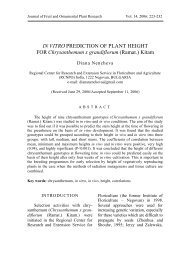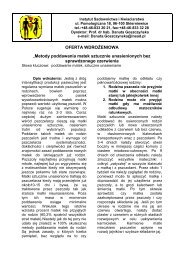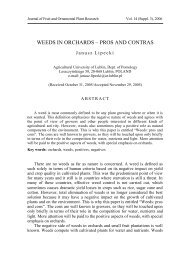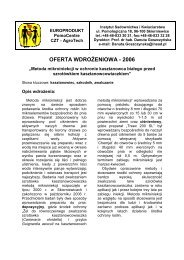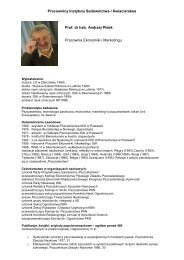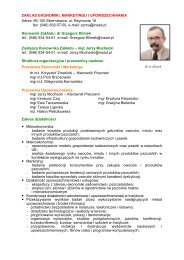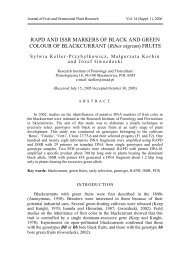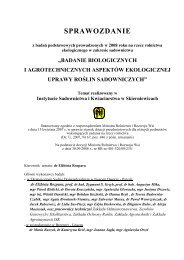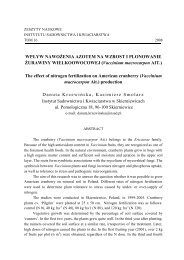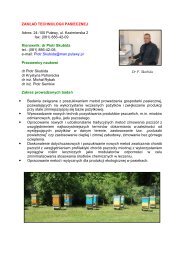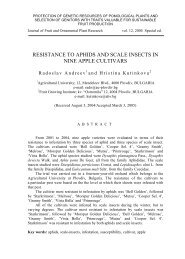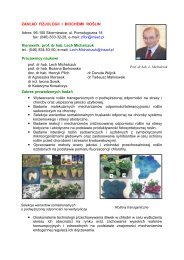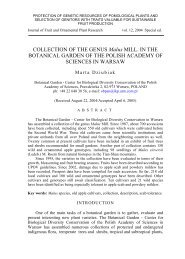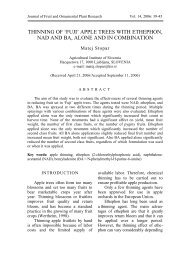The benefits of Vaccinium species in ecological production
The benefits of Vaccinium species in ecological production
The benefits of Vaccinium species in ecological production
Create successful ePaper yourself
Turn your PDF publications into a flip-book with our unique Google optimized e-Paper software.
ORCHARD MANAGEMENT IN SUSTAINABLE FRUIT PRODUCTION<br />
Journal <strong>of</strong> Fruit and Ornamental Plant Research<br />
vol. 12, 2004 Special ed.<br />
THE BENEFITS OF <strong>Vacc<strong>in</strong>ium</strong> SPECIES IN<br />
ECOLOGICAL PRODUCTION<br />
Danuta Krzewińska<br />
Research Institute <strong>of</strong> Pomology and Floriculture, Skierniewice<br />
Pomologiczna 18, 96100 Skierniewice, POLAND<br />
dkrzew@<strong>in</strong>sad.pl<br />
(Received May 7, 2004/Accepted September 17, 2004)<br />
ABSTRACT<br />
More and more people are buy<strong>in</strong>g foods labeled as ‘natural’ or ‘<strong>ecological</strong>’. It is<br />
much easier to cultivate <strong>Vacc<strong>in</strong>ium</strong> <strong>species</strong> accord<strong>in</strong>g to <strong>ecological</strong> rules than most<br />
fruit <strong>species</strong>. Grow<strong>in</strong>g cranberries and highbush and lowbush blueberries is an<br />
<strong>in</strong>terest<strong>in</strong>g way to diversify agriculture and improve the pr<strong>of</strong>itability <strong>of</strong> small family<br />
farms. <strong>The</strong> <strong>ecological</strong> <strong>benefits</strong> <strong>of</strong> <strong>Vacc<strong>in</strong>ium</strong> <strong>species</strong> are reviewed and discussed.<br />
Key words: <strong>Vacc<strong>in</strong>ium</strong>, environment, mycorrhiza, mulch<strong>in</strong>g, fertilization, plant<br />
protection, <strong>ecological</strong> <strong>production</strong><br />
INTRODUCTION<br />
<strong>Vacc<strong>in</strong>ium</strong> <strong>species</strong> are an important fruit crop <strong>in</strong> many countries all over<br />
the world (Frith and ClaytonGreene, 1993; Moore, 1993; MunozSchick and<br />
ClaytonGreene, 1993; Tamada and ClaytonGreene, 1993). Blueberry and<br />
cranberry <strong>production</strong> have <strong>in</strong>creased <strong>in</strong> recent years (Tr<strong>in</strong>ka et al., 1997;<br />
Caruso et al., 1997). In the USA, there are also some wild <strong>Vacc<strong>in</strong>ium</strong> <strong>species</strong><br />
(V. angustifolium Ait., V. ashei Reade, V. macrocarpon Ait.) which have been<br />
grown commercially after improvements <strong>in</strong> field management (Yarborough<br />
and Smagula, 1997).<br />
In Poland and Eastern Europe, native wild <strong>species</strong>, such as V. myrtillus L.,<br />
V. vitisidaea L., V. ulig<strong>in</strong>osum L., and V. oxycoccus, have not yet been<br />
exploited as commercial crops (Pliszka and ClaytonGreene, 1993), though<br />
blueberries (V. corymbosum L.) have been commercially grown s<strong>in</strong>ce the<br />
1970’s. Cranberries (V. macrocarpon Ait.) are also now grown, but not as<br />
widely as highbush blueberries are.
D. Krzewińska<br />
Fruits <strong>of</strong> <strong>Vacc<strong>in</strong>ium</strong> <strong>species</strong> conta<strong>in</strong> abundant antioxidants, which<br />
function by neutraliz<strong>in</strong>g oxygen free radicals (Heimhuber and Herrmann,<br />
1990). <strong>The</strong>y are widely considered to be one <strong>of</strong> the healthiest foods available<br />
(Ma<strong>in</strong>land and Tucker, 2002), and are a excellent source <strong>of</strong> fiber, calcium,<br />
iron, vitam<strong>in</strong> C, total phenolics, and anthocyan<strong>in</strong>s (Ehlenfeldt and Prior,<br />
2000). <strong>The</strong> antioxidant activity <strong>of</strong> blueberries depends on genotype,<br />
environment (Connor et al., 2002), and horticultural traits, such as yield and<br />
fruit size (Vorsa et al., 2002).<br />
1. Environmental factors<br />
<strong>Vacc<strong>in</strong>ium</strong> <strong>species</strong> need special climate and soil conditions for optimal<br />
growth and productivity (Coville, 1910; Eck, 1988). <strong>The</strong>y need about 160<br />
days for vegetative growth, followed by a period <strong>of</strong> low temperatures (Hafner,<br />
1993).<br />
In northern climates, <strong>Vacc<strong>in</strong>ium</strong> cultivars which are cold tolerant and bear<br />
no later than ‘Bluecrop’ are most suitable for pr<strong>of</strong>itable <strong>production</strong> (Hiirsalmi,<br />
1993; Vestrheim et al., 1997). Other cultivars can be grown us<strong>in</strong>g plastic<br />
tunnels (Bal et al., 1997).<br />
In southern climates, cultivars with a very low chill<strong>in</strong>g requirement, such<br />
as southern highbush blueberry or rabbiteye blueberry (V. ashei Reade), are<br />
best for pr<strong>of</strong>itable cultivation (Reeder et al., 1998).<br />
<strong>The</strong> specific site and soil requirements <strong>of</strong> <strong>Vacc<strong>in</strong>ium</strong> <strong>species</strong> limit<br />
commercial grow<strong>in</strong>g. <strong>Vacc<strong>in</strong>ium</strong> <strong>species</strong> need well dra<strong>in</strong>ed acid soil (pH KCl<br />
3.54.0) with a high content <strong>of</strong> organic matter. Because <strong>of</strong> their shallow root<br />
systems, they need soils which are well aerated and sufficiently moist <strong>in</strong> the<br />
upper layer. <strong>The</strong>y can be grown on many different soil types (Korcak, 1989;<br />
Moore and ClaytonGreene, 1993), which may require pH adjustment or the<br />
addition <strong>of</strong> organic matter before plant<strong>in</strong>g. Apply<strong>in</strong>g sulfur is a good way to<br />
lower the soil pH (Moore, 1993). Add<strong>in</strong>g organic matter and mulch<strong>in</strong>g with<br />
peat, sawdust, bark, or moss also help lower soil pH. Organic matter also<br />
improves soil structure. <strong>The</strong> range <strong>of</strong> sites amenable to blueberry <strong>production</strong><br />
could be extended by breed<strong>in</strong>g for upland soil adaptability, optimiz<strong>in</strong>g<br />
management techniques, and amend<strong>in</strong>g upland soils (Korcak, 1988; F<strong>in</strong>n et<br />
al., 1993; Dale et al., 1989; Goulart et al., 1997).<br />
Environmental stresses (w<strong>in</strong>d, cold, drought, flood<strong>in</strong>g and m<strong>in</strong>eral<br />
deficiencies) have negative impacts on plant growth, which need to be<br />
reduced. W<strong>in</strong>d may drastically limit plant development (Percival et al., 2002),<br />
and may be reduced by natural w<strong>in</strong>dbreaks, such as forests or s<strong>in</strong>gle rows <strong>of</strong><br />
trees, or by artificial w<strong>in</strong>dbreaks. Cold can damage plants both <strong>in</strong> w<strong>in</strong>ter,<br />
depend<strong>in</strong>g on the temperature schedule and snow cover, and <strong>in</strong> spr<strong>in</strong>g, when<br />
the plants blossom. Overhead irrigation can protect flowers and fruits aga<strong>in</strong>st<br />
frost (Lyrene et al., 1997). Water availability can be improved by irrigation<br />
and mulch<strong>in</strong>g. Stand<strong>in</strong>g water can damage blueberry roots, and even kill the<br />
50<br />
J. Fruit Ornam. Plant Res. Special ed. vol. 12, 2004: 4961
<strong>The</strong> <strong>benefits</strong> <strong>of</strong> <strong>Vacc<strong>in</strong>ium</strong> <strong>species</strong> <strong>in</strong> <strong>ecological</strong> <strong>production</strong><br />
plants, depend<strong>in</strong>g on cultivar and time <strong>of</strong> flood<strong>in</strong>g (Silva et al., 1999; L<strong>in</strong> et<br />
al., 2002). M<strong>in</strong>eral deficiencies can be reduced by fertiliz<strong>in</strong>g, by<br />
<strong>in</strong>corporat<strong>in</strong>g organic matter <strong>in</strong>to the soil, and by mulch<strong>in</strong>g.<br />
2. Plants<br />
High quality, healthy, vigorous plants which are free from viruses and<br />
which have good roots should be selected for plant<strong>in</strong>g, because they are more<br />
resistant to stress. Some cultivars are especially cold hardy and relatively<br />
resistant to diseases and pests, even dur<strong>in</strong>g ra<strong>in</strong>y seasons.<br />
3. Management after plant<strong>in</strong>g<br />
Rational use <strong>of</strong> water, fertilizers, chemicals, and other <strong>in</strong>puts ensures<br />
susta<strong>in</strong>able crop <strong>production</strong> with m<strong>in</strong>imal damage to the environment. In<br />
blueberry <strong>production</strong>, weeds may be controlled by clean cultivation with<br />
mechanical weed control, or by us<strong>in</strong>g grasseddown rows or mulches such as<br />
peat, bark, sawdust, or moss. Mulch<strong>in</strong>g, which also conserves soil moisture,<br />
is the most widely used method <strong>of</strong> weed control (Schmidt, 1989). In the USA,<br />
mulch<strong>in</strong>g with about 15 cm <strong>of</strong> milled p<strong>in</strong>e bark is recommended, although<br />
less expensive mulches have also been tested (Krewer et al., 2002). Mulch<strong>in</strong>g<br />
and soil amendment <strong>in</strong>crease plant growth and vigor (Dale et al., 1989;<br />
Goulart et al., 1995; Mercik et al., 1995; Pliszka et al., 1993), sometimes even<br />
more so than fertiliz<strong>in</strong>g (Scibisz et al., 1998).<br />
Synthetic mulches can be used <strong>in</strong> organic <strong>production</strong>, but are not as good<br />
as p<strong>in</strong>e bark or peat (Norden, 1989; Starast et al., 2002). <strong>The</strong> best synthetic<br />
mulch is nonwoven fabric, although black plastic is also good.<br />
Individual growers need to visually exam<strong>in</strong>e their blueberry or cranberry<br />
plants and chemically analyze soil and leaves <strong>in</strong> order to determ<strong>in</strong>e the best<br />
fertiliz<strong>in</strong>g levels and schedules. <strong>Vacc<strong>in</strong>ium</strong> <strong>species</strong> need much less fertilizer<br />
than other fruit crops. Care <strong>in</strong> us<strong>in</strong>g nitrogen fertilizers can m<strong>in</strong>imalize<br />
damage to the environment, especially to groundwater. Ammonium sulfate is<br />
the best fertilizer because it conta<strong>in</strong>s readily available nitrogen and is more<br />
effective <strong>in</strong> the root zone (F<strong>in</strong>n et al., 1997). However, the choice <strong>of</strong> nitrogen<br />
fertilizer does not significantly effect the concentrations <strong>of</strong> nitrogen and other<br />
elements <strong>in</strong> leaves (F<strong>in</strong>n et al., 1997; Clark and Naraguma, 1998). Nitrogen<br />
absorption appears to be affected more by the plant demand than by soil<br />
availability (Throop and Hanson, 1997). Nitrogen is most effectively absorbed<br />
dur<strong>in</strong>g active plant growth, between late bloom and fruit maturity. Apply<strong>in</strong>g<br />
nitrogen to the soil is far more effective than apply<strong>in</strong>g nitrogen to the leaves.<br />
(Widders and Hancock, 1994). Fertiliz<strong>in</strong>g <strong>in</strong> divided doses is better both for<br />
plant growth and the environment than fertiliz<strong>in</strong>g <strong>in</strong> one large s<strong>in</strong>gle dose<br />
(Hanson and Retamales, 1992. Virg<strong>in</strong> acidic soils need to be fertilized for<br />
successful blueberry <strong>production</strong> (Aust<strong>in</strong> and Bondari, 1989). Decomposition<br />
J. Fruit Ornam. Plant Res. Special ed. vol. 12, 2004: 4961 51
D. Krzewińska<br />
<strong>of</strong> soil organic matter releases nitrogen <strong>in</strong> two forms: ammonium and nitrate.<br />
Release rates depend on soil temperature, moisture, and organic matter<br />
content (Hart et al., 1994). Ammonium, the <strong>in</strong>itial product <strong>of</strong> the breakdown<br />
<strong>of</strong> soil organic matter, is the form preferred by <strong>Vacc<strong>in</strong>ium</strong> plants, because they<br />
are acidophilic (Smith, 1993; Claussen and Lenz, 1999). Much more nitrogen<br />
is released <strong>in</strong> organic soils than <strong>in</strong> m<strong>in</strong>eral soils (Davenport and<br />
DeMoranville, 1997). Overfertilization with nitrogen does not reduce fruit<br />
yield and fruit quality <strong>of</strong> plants grow<strong>in</strong>g <strong>in</strong> organic soils as much as it reduces<br />
fruit yield and quality <strong>of</strong> plants grow<strong>in</strong>g <strong>in</strong> other soils (Davenport,<br />
1996;1997). Prelim<strong>in</strong>ary results from a trial <strong>in</strong> Skierniewice <strong>in</strong>dicate that the<br />
‘Pilgrim’ cultivar grew vigorously and suffered much less preharvest and<br />
postharvest fruit rot when not fertilized or fertilized at low rates <strong>of</strong> nitrogen,<br />
than when fertilized at high rates. (Krzewińska et al., unpublished).<br />
Different cultivars respond similarly to m<strong>in</strong>eral fertilization when grown<br />
on sterile peat <strong>in</strong> the absence <strong>of</strong> mycorrhizal fungi (Eccher et al., 2002). <strong>The</strong><br />
presence <strong>of</strong> mycorrhiza greatly <strong>in</strong>creases the uptake <strong>of</strong> m<strong>in</strong>erals, especially<br />
nitrogen and phosphorus. Symbiosis between blueberries and fungi <strong>in</strong>creases<br />
nitrogen and phosphorus absorption, as well as resistance to stress and<br />
pathogenic microorganisms (Koron et al., 2000). Mycorrhizal plants can grow<br />
<strong>in</strong> soils too poor for most other plant <strong>species</strong>. <strong>The</strong> level <strong>of</strong> mycorrhiza<br />
formation depends on <strong>species</strong> and cultivar, as well as on soil type (Noé et al.,<br />
2002). <strong>The</strong>re are multiple <strong>in</strong>teractions between cultivar, fungus and fertilizer.<br />
Mycorrhiza plays an important role <strong>in</strong> the ecology <strong>of</strong> wild plants. In<br />
commercial <strong>production</strong>, mycorrhiza reduces the amount <strong>of</strong> fertilizers and<br />
other chemicals needed, which is important for the development <strong>of</strong><br />
susta<strong>in</strong>able agriculture (Noé et al., 2002).<br />
Irrigation depends on ra<strong>in</strong>fall and temperature, especially <strong>in</strong> poor, sandy<br />
soils. Irrigation improves growth and yield (Holzapfel et al., 1997; Holzapfel<br />
and Hepp, 2002). <strong>The</strong> availability <strong>of</strong> water is critical dur<strong>in</strong>g fruit formation. In<br />
blueberry cultivation, a dry spell after pick<strong>in</strong>g can affect <strong>production</strong> the<br />
follow<strong>in</strong>g year (Perrier et al., 2000). Blueberries require an average <strong>of</strong> about<br />
25 mm <strong>of</strong> ra<strong>in</strong> a week, and about 40 mm dur<strong>in</strong>g the pick<strong>in</strong>g season.<br />
Cranberries require an average <strong>of</strong> about 7 mm <strong>of</strong> ra<strong>in</strong> a week, and about 17<br />
mm dur<strong>in</strong>g the pick<strong>in</strong>g season (Haffner, 1993; Hattendorf and Davenport,<br />
1996).<br />
Poll<strong>in</strong>ation <strong>in</strong>creases fruit set and yield, and depends on <strong>species</strong> and<br />
cultivar (MacKenzie, 1997), on weather conditions dur<strong>in</strong>g flower<strong>in</strong>g, and on<br />
the total numbers <strong>of</strong> poll<strong>in</strong>ators (Eaton et al., 1997). Blueberries and<br />
cranberries require <strong>in</strong>sects for poll<strong>in</strong>ation (Coville, 1910; MacKenzie et al.,<br />
1997).<br />
High density plant<strong>in</strong>g <strong>of</strong> highbush blueberries is a good way to maximize<br />
<strong>production</strong> and to reduce the time to full <strong>production</strong> (Moore et al., 1993;<br />
1994). Standard blueberry plants have to be pruned every year. Remov<strong>in</strong>g old,<br />
52<br />
J. Fruit Ornam. Plant Res. Special ed. vol. 12, 2004: 4961
<strong>The</strong> <strong>benefits</strong> <strong>of</strong> <strong>Vacc<strong>in</strong>ium</strong> <strong>species</strong> <strong>in</strong> <strong>ecological</strong> <strong>production</strong><br />
weak and broken branches <strong>in</strong>creases fruit yield and fruit weight, reduces<br />
anthracnose rot <strong>in</strong> berries, and regulates leaf/fruit ratio and flower count<br />
(Jansen et al., 1997; Lyrene et al., 1997; Smolarz and Paal, 1998; Smolarz and<br />
Chlebowska, 2002; Hanson et al., 2000; Suzuki et al., 1998).<br />
Earlier harvests are possible if plastic tunnels are used. Later harvests are<br />
possible if ra<strong>in</strong> covers are used, especially with latematur<strong>in</strong>g cultivars (Bal et<br />
al., 1997), although improved fruit storage techniques <strong>in</strong> a controlled atmosphere<br />
have reduced the need for this.<br />
4. Plant protection<br />
<strong>Vacc<strong>in</strong>ium</strong> <strong>species</strong> are more resistant than other plants to diseases and<br />
pests. Nevertheless, the plants constantly need to be visually monitored for<br />
a great number <strong>of</strong> pests and diseases. Symptoms can vary widely depend<strong>in</strong>g<br />
on cultivar, stage <strong>of</strong> growth, and application method. Synergistic effects are<br />
possible. For example, plants <strong>in</strong>fected by Botryosphaeria dothidea after be<strong>in</strong>g<br />
<strong>in</strong>jured by the cold are even smaller than if they had only been <strong>in</strong>jured by the<br />
cold (Cl<strong>in</strong>e, 1995; Cl<strong>in</strong>e et al., 1997).<br />
In the USA, different diseases predom<strong>in</strong>ate <strong>in</strong> different parts <strong>of</strong> the<br />
country. Cottonball (Monil<strong>in</strong>ia oxycocci = (Monilia oxycocci)) is a serious<br />
disease <strong>in</strong> Wiscons<strong>in</strong> (Caruso and Ramsdell, 1995). Early rot (Phyllosticta<br />
vacc<strong>in</strong>ii) and bitter rot (Glomerella c<strong>in</strong>gulata) are serious <strong>in</strong> Massachusetts<br />
(Qudemans et al., 1998). Fruit rots caused by Colletotrichum acutatum<br />
(anthracnose), Alternaria spp. and Botrytis c<strong>in</strong>erea are serious <strong>in</strong> Michigan<br />
(Schilder et al., 2002). Sunscald, <strong>in</strong>sects, and mechanical damage can make<br />
plants more susceptible to rot. Fruit rots are difficult to control. <strong>The</strong>y are<br />
usually controlled with fungicides (Schilder et al., 2002). It is important to<br />
confirm which pathogens are present before decid<strong>in</strong>g on a control program. It<br />
is also important to use as little pesticide as necessary, and to apply it <strong>in</strong> the<br />
most efficient manner possible. For example, when an overtherow sprayer is<br />
used, only onethird the amount <strong>of</strong> fungicide is needed than when<br />
a conventional sprayer is used (Hanson et al., 1997; 2000).<br />
In North America, mummy berry (Monil<strong>in</strong>ia vacc<strong>in</strong>iicorymbosi<br />
(=Monilia vacc<strong>in</strong>iicorymbosi)) is one <strong>of</strong> the most important fungal diseases<br />
(Eck, 1988). Horticultural cultivars can be crossed with wild <strong>species</strong> to<br />
produce cultivars which are more resistant to mummy berry (Stretch et al.,<br />
2001). Grow<strong>in</strong>g diseaseresistant cultivars is economically and environmentally<br />
wise, because the need for fungicides is reduced, or even elim<strong>in</strong>ated<br />
(Ehlenfeldt and Stretch, 2002).<br />
Little is known about blueberry and cranberry diseases <strong>in</strong> Poland, even<br />
though the cultivation <strong>of</strong> <strong>Vacc<strong>in</strong>ium</strong> <strong>species</strong> has <strong>in</strong>creased. In one grower’s<br />
op<strong>in</strong>ion, there are two or three diseases <strong>in</strong> Poland, none <strong>of</strong> which is difficult to<br />
control (H. Karwowska, personal communication).<br />
J. Fruit Ornam. Plant Res. Special ed. vol. 12, 2004: 4961 53
D. Krzewińska<br />
Knowledge <strong>of</strong> the habits and life cycles <strong>of</strong> pests is essential for effective<br />
control (Cockfield and Mahr, 1994). Some pests can be controlled by us<strong>in</strong>g<br />
natural enemies, commerciallyraised parasitoids (Simser, 1994; Mitchell et<br />
al., 1999; Polavarapu et al., 2000), green sphere boards, or pheromone blends<br />
(Cockfield et al., 1994; Liburd et al., 2000).<br />
Some blueberry cultivars are more susceptible to larval <strong>in</strong>festation<br />
because <strong>of</strong> <strong>in</strong>teractions between the lifecycles <strong>of</strong> both plant and pest. For<br />
example, Rhagoletis mendax lays it eggs when midseason cultivars are<br />
ripen<strong>in</strong>g (Liburd et al., 1998).<br />
Flood<strong>in</strong>g and sand<strong>in</strong>g are two <strong>in</strong>terest<strong>in</strong>g, <strong>ecological</strong> methods <strong>of</strong> pest<br />
control <strong>in</strong> cranberry grow<strong>in</strong>g. Flood<strong>in</strong>g dur<strong>in</strong>g spr<strong>in</strong>g reduces the number <strong>of</strong><br />
Rhopobota unipunctana larvae (Cockfield and Mahr, 1992), and decreases<br />
fruit rot and Acrobasis vacc<strong>in</strong>ii <strong>in</strong>festation (Averill et al., 1997). Apply<strong>in</strong>g 1.3<br />
cm <strong>of</strong> sand to the surface <strong>of</strong> V. macrocarpon plantations controls <strong>in</strong>sect pests<br />
without decreas<strong>in</strong>g yield (Davenport and Schiffhauer, 2000). Apply<strong>in</strong>g at least<br />
2.5 cm <strong>of</strong> sand controls swamp dodder (Cascuta gronovii, Sandler et al.,<br />
1997.)<br />
Viruses can cause enormous damage because they spread so quickly. It is<br />
practically impossible to elim<strong>in</strong>ate all sources <strong>of</strong> all viruses. Viruses are <strong>of</strong>ten<br />
transmitted by aphids(Bristow et al., 2000).<br />
Birds are another serious problem <strong>in</strong> <strong>Vacc<strong>in</strong>ium</strong> <strong>production</strong>. <strong>The</strong>y are<br />
extremely difficult to control, although us<strong>in</strong>g bird nett<strong>in</strong>g before fruit ripen<strong>in</strong>g<br />
is the most effective treatment, accord<strong>in</strong>g to a study carried out <strong>in</strong> the USA<br />
(V<strong>in</strong>cent and Lareau, 1993; Curtis et al., 1994). Sucrose accumulation <strong>in</strong> fruits<br />
deters birds, and could be a valuable addition to current strategies <strong>of</strong> bird<br />
control (Darnell et al., 1994).<br />
On <strong>ecological</strong> farms, plants can be protected only with mechanical<br />
methods, such as remov<strong>in</strong>g damaged canes, protect<strong>in</strong>g beneficial fauna,<br />
nett<strong>in</strong>g aga<strong>in</strong>st birds, and plant<strong>in</strong>g new, multiresistant cultivars.<br />
CONCLUSION<br />
In ecologyfriendly <strong>Vacc<strong>in</strong>ium</strong> cultivation, attention must be paid to:<br />
site selection;<br />
multiple resistance <strong>of</strong> cultivars to diseases, pests and cold;<br />
improvements <strong>in</strong> weed control (mulch<strong>in</strong>g, sand<strong>in</strong>g);<br />
improvements <strong>in</strong> disease, pest and bird control, (natural enemies,<br />
pheromones, nett<strong>in</strong>g);<br />
nutrient management (organic matter <strong>in</strong>corporation and fertilization<br />
based on analysis <strong>of</strong> leaf tissue);<br />
54<br />
J. Fruit Ornam. Plant Res. Special ed. vol. 12, 2004: 4961
<strong>The</strong> <strong>benefits</strong> <strong>of</strong> <strong>Vacc<strong>in</strong>ium</strong> <strong>species</strong> <strong>in</strong> <strong>ecological</strong> <strong>production</strong><br />
water management (<strong>in</strong>clud<strong>in</strong>g overhead spr<strong>in</strong>klers for frost<br />
protection);<br />
yield improvement (prun<strong>in</strong>g, th<strong>in</strong>n<strong>in</strong>g, improv<strong>in</strong>g flower bud set and<br />
fruit size).<br />
REFERENCES<br />
Aust<strong>in</strong> M.E., Bondari K. 1989. Studies on the response <strong>of</strong> 'Tifblue' and<br />
'Woodard' rabbiteye blueberries to fertilizers. II. Effect <strong>of</strong> nitrogen source on yield,<br />
fruit size, growth, vigor and foliage color. FERTILIZER RES. 20(3): 173180.<br />
Averill A.L., Sylvia M.M., Kusek C.C., DeMoranville<br />
C.J. 1997. Flood<strong>in</strong>g <strong>in</strong> cranberry to m<strong>in</strong>imize <strong>in</strong>secticide and fungicide <strong>in</strong>puts.<br />
AMER. J. ALTERNATIVE AGRI. 12 (2): 5054.<br />
Bal J., Yarborough D.E. (ed.), Smagula J.M. 1997. Blueberry<br />
culture <strong>in</strong> greenhouses, tunnels, and under ra<strong>in</strong>covers. ACTA HORT. 446: 327331.<br />
Bristow P.R., Mart<strong>in</strong> R.R., W<strong>in</strong>dom G.E. 2000. Transmission,<br />
field spread, cultivar response, and impact on yield <strong>in</strong> highbush blueberry<br />
<strong>in</strong>fected with blueberry scorch virus. PHYTOPATHOLOGY 90(5): 474479.<br />
Caruso F.L., Ramsdell D.C. 1995. Compendium <strong>of</strong> blueberry and<br />
cranberry diseases, <strong>The</strong> American Phytopathological Society, St. Paul, MN<br />
Caruso F.L., Yarborough D.E. (ed.), Smagula J.M. 1997.<br />
Trends <strong>in</strong> cranberry <strong>production</strong>. ACTA HORT. 446: 4145.<br />
Clark J.R., Naraguma J., Allen A. 1998. Highbush blueberry response<br />
to nitrogen rate and method <strong>of</strong> application: fourthyear results. Res. Series<br />
Arkansas AGRI. EXPER. STA. 459: 4346.<br />
Claussen W., Lenz F. 1999. Effect <strong>of</strong> ammonium or nitrate nutrition on net<br />
photosynthesis, growth, and activity <strong>of</strong> the enzymes nitrate reductase and<br />
glutam<strong>in</strong>e synthetase <strong>in</strong> blueberry, raspberry and strawberry. PLANT AND SOIL<br />
208(1): 95102.<br />
Cl<strong>in</strong>e W.O. 1995. Infection <strong>of</strong> cold<strong>in</strong>jured blueberry stems by Botryosphaeria<br />
dothidea. J. SMALL FRUIT VITICUL. 3(23): 9598.<br />
Cl<strong>in</strong>e W.O., Yarborough D.E. (ed.), Smagula J.M. 1997.<br />
Predict<strong>in</strong>g blueberry stem bligh <strong>in</strong> new plant<strong>in</strong>gs. ACTA HORT. 446: 421426.<br />
Cockfield S.D., Mahr D.L. 1992. Flood<strong>in</strong>g cranberry beds to control<br />
blackheaded fireworm (Lepidoptera: Tortricidae). J. ECON. ENT. 85(6): 23832388.<br />
Cockfield S.D., Mahr D.L. 1994. Phenology <strong>of</strong> oviposition <strong>of</strong> Dasyneura<br />
oxycoccana (Diptera: Cecidomyiidae) <strong>in</strong> relation to cranberry plant growth and<br />
flower<strong>in</strong>g. GREAT LAKES ENT. 27(4): 185188.<br />
Cockfield S.D., Fitzpatrick S.M., Patten K., Henderson<br />
D., Dittl T., Poole A., Shanks C., Mahr D.L. 1994.<br />
Model<strong>in</strong>g <strong>of</strong> blackheaded fireworm (Lepidoptera: Tortricidae) oviposition and<br />
pheromonetrap catches. J. ECON. ENT. 87(3): 787792.<br />
Connor A.M., Lubby J.J., Tong C.B.S., F<strong>in</strong>n C.E.,<br />
Hancock J.F. 2002. Genotypic an environmental variation <strong>in</strong> antioxidant<br />
activity among blueberry cultivars. ACTA HORT. 574: 209213.<br />
Covile F.V. 1910. Experiments <strong>in</strong> blueberry culture. U.S. Dep. Agr. Bull. 193.<br />
J. Fruit Ornam. Plant Res. Special ed. vol. 12, 2004: 4961 55
D. Krzewińska<br />
Curtis P.D., Merw<strong>in</strong> I.A., Pritts M.P., Peterson D.V. 1994.<br />
Chemical repellents and plastic nett<strong>in</strong>g for reduc<strong>in</strong>g bird damage to sweet<br />
cherries, blueberries, and grapes. HORTSCIENCE. 29 (10): 11511155.<br />
Dale A., Cl<strong>in</strong>e R.A., Ricketson C.L. 1989. Soil management and<br />
irrigation studies with highbush blueberries. ACTA HORT. 241: 120125.<br />
Darnell R.L., CanoMedrano R., Koch K.E., Avery M.L.<br />
1994. Differences <strong>in</strong> sucrose metabolism relative to accumulation <strong>of</strong> birddeterrent<br />
sucrose levels <strong>in</strong> fruits <strong>of</strong> wild and domestic <strong>Vacc<strong>in</strong>ium</strong> <strong>species</strong>.<br />
PHYSIOL. PLANT. 92(2): 336342.<br />
Davenport J.R. 1996. <strong>The</strong> effect <strong>of</strong> nitrogen fertilizer rates and tim<strong>in</strong>g on<br />
cranberry yield and fruit quality. J. AMER. SOC. HORT. SCI. 12 (6): 10891094.<br />
Davenport J.R. 1997. Nitrogen fertilizer management for British Columbia<br />
cranberry <strong>production</strong>. CRANBERRIES 61 (4): 1317<br />
Davenport J.R., DeMoranville C.J. 1997. Nitrogen fertilizer use and<br />
management <strong>in</strong> cranberry systems. F<strong>in</strong>al Rep. AgroEnvironmental Technol.<br />
Grant Program Massachusetts Dept. Food Agri.<br />
Davenport J.R., Schiffhauer D.E. 2000. Cultivar <strong>in</strong>fluences cranberry<br />
response to surface sand<strong>in</strong>g. HORTSCIENCE 35(1): 5354.<br />
Davenport J.R., Patten K.D. 2002. Nitrogen release <strong>in</strong> virg<strong>in</strong> and<br />
cultivated organic cranberry soils. ACTA HORT. 574: 341346.<br />
Eaton L.J., Murray J.E., Yarborough D.E. (ed.), Smagula<br />
J.M. 1997. Relationships <strong>of</strong> poll<strong>in</strong>ator numbers <strong>in</strong> blueberry fields to fruit<br />
development and yields. ACTA HORT. 446: 181188.<br />
Eccher T., Noé N., Villa C. 2002. Interaction between mycorrhization<br />
with different selected fungi and m<strong>in</strong>eral fertilization <strong>of</strong> <strong>Vacc<strong>in</strong>ium</strong> corymbosum<br />
L. micropropagated plants. ACTA HORT. 574: 379385.<br />
Eck P. 1988. Blueberry science. Rutgers Univ. Press, New Brunswick, NJ 284 p.<br />
Ehlenfeldt M.K., Stretch A. 2002. Identify<strong>in</strong>g sources <strong>of</strong> resistance to<br />
mummy berry and anthracnose <strong>in</strong> highbush, rabbiteye, and <strong>species</strong> germ plasm.<br />
ACTA HORT. 574: 6369.<br />
Ehlenfeldt M. Prior R.L. 2000. Oxygen radical absorbance capacity<br />
(ORAC), phenolic, and anthocyjan concentration <strong>in</strong> fruit and leaf tissue <strong>of</strong><br />
highbush blueberry. (abstract) HORTSCIENCE 35: 487.<br />
F<strong>in</strong>n C.E., Luby J.J., Rosen C.J., Ascher P.D. 1993. Blueberry<br />
germplasm screen<strong>in</strong>g at several soil pH regimes, I Plant survival and growth.<br />
J. AMER. SOC. HORT. SCI. 118: 377382.<br />
F<strong>in</strong>n C.E., Warmund M.R., Yarborough D.E. (ed.),<br />
Smagula J.M. 1997. Fertigation vs. surface application <strong>of</strong> nitrogen dur<strong>in</strong>g<br />
blueberry plant establishment. ACTA HORT. 446: 397401.<br />
Frith G.J.T., ClaytonGreene K.A. 1993. <strong>The</strong> development <strong>of</strong><br />
a highbush blueberry (<strong>Vacc<strong>in</strong>ium</strong> corymbosum) <strong>in</strong>dustry <strong>in</strong> Australia. ACTA<br />
HORT. 346: 5962.<br />
Goulart B.L., Demchak K., YangWeiQiang, Yang W.Q.,<br />
Gough R.E. 1995. Organic matter and nitrogen level effects on mycorrhizal<br />
<strong>in</strong>fection <strong>in</strong> 'Bluecrop' highbush blueberry plants. J. SMALL FRUIT VITICUL.<br />
3(4): 151164.<br />
56<br />
J. Fruit Ornam. Plant Res. Special ed. vol. 12, 2004: 4961
<strong>The</strong> <strong>benefits</strong> <strong>of</strong> <strong>Vacc<strong>in</strong>ium</strong> <strong>species</strong> <strong>in</strong> <strong>ecological</strong> <strong>production</strong><br />
Goulart B.L., Demchak K., YangWeiQiang, Yang W.Q.,<br />
Yarborough D.E. (ed.), Smagula J.M. 1997. Effect <strong>of</strong> cultural<br />
practices on field grown Bluecrop highbush blueberries, with emphasis on<br />
mycorrhizal <strong>in</strong>fection levels. ACTA HORT. 446: 271278.<br />
Haffner K.E. 1993. Ecology <strong>of</strong> <strong>Vacc<strong>in</strong>ium</strong> grow<strong>in</strong>g. ACTA HORT. 346: 214220.<br />
Hanson E., Hancock J., Ramsdell D.C., Schilder A.,<br />
VanEe G., Ledebuhr R. 2000. Sprayer type and prun<strong>in</strong>g affect the<br />
<strong>in</strong>cidence <strong>of</strong> blueberry fruit rots. HORTSCIENCE 35 (2): 235238.<br />
Hanson E.J., Retamales J.B. 1992. Effect <strong>of</strong> nitrogen source and tim<strong>in</strong>g<br />
on highbush blueberry performance. HORTSCIENCE 27(12): 12651267.<br />
Hanson E.J., VanEe G.R., Ramsdell D.C., Hancock J.F.,<br />
Flore J.A., Yarborough D.E. (ed.), Smagula J.M. 1997.<br />
Improved sprayer technology to reduce fungicide use <strong>in</strong> blueberry <strong>production</strong>.<br />
HORTSCIENCE 446: 439445.<br />
Hart S.C., Stark J.M., Davidson E.A., Firestone M.K. 1994.<br />
Nitrogen m<strong>in</strong>eralization, immobilization, and nitrification. In: Methods <strong>of</strong> Soil<br />
Analysis, Part 2. Microbiological and Biochemical Properties. SSSA Book Series,<br />
No. 5, Madison WI.<br />
Hattendorf M.J., Davenport J.R. 1996. Cranberry evapotranspiration.<br />
HORTSCIENCE 31(3): 334337.<br />
Heimhuber B., Herrmann K. 1990. Benzoe, Phenylessig, 3<br />
Phenylpropan und Zimtsaure sowie Benzoylglucosen <strong>in</strong> e<strong>in</strong>igen Obst und<br />
Fruchtgemusearten. DEUTSCHE LEBENSMITTEL RUNDSCHAU 86(7): 205209.<br />
Hiirsalmi H. 1993. <strong>The</strong> role <strong>of</strong> natural small fruits <strong>in</strong> F<strong>in</strong>nish plant breed<strong>in</strong>g.<br />
AQUILO. SER. BOTANICA 31: 5967.<br />
Holzapfel E.A., Hepp R.F. 2002. Effect <strong>of</strong> Irrigation on Six Years Old<br />
Bluetta Blueberry Plants. ACTA HORT. 574: 253259.<br />
Holzapfel E.A., Hepp R.F., Yarborough D.E. (ed.),<br />
Smagula J.M. 1997. Effect <strong>of</strong> microjet and drip irrigation on fruit<br />
<strong>production</strong> <strong>of</strong> highbush blueberry. ACTA HORT. 446: 259264.<br />
Jansen W.A.G.M., Yarborough D.E. (ed.), Smagula J.M.<br />
1997. Prun<strong>in</strong>g <strong>of</strong> highbush blueberries. ACTA HORT. 446: 333335.<br />
Korcak R.F. 1988. Blueberry <strong>species</strong> and cultivar response to soil types.<br />
J. SMALL FRUIT VITICUL. 1: 1124.<br />
Korcak R.F. 1989. Adaptability <strong>of</strong> blueberry <strong>species</strong> to various soil types: III.<br />
F<strong>in</strong>al growth and tissue analyses. J. PLANT NUTRITION 12(11): 12731292.<br />
Koron D., Gogala N., Muller W. (ed.), Polesny F. (ed.),<br />
Verheyden C. (ed.), Webster A.D. 2000. <strong>The</strong> use <strong>of</strong> mycorrhizal<br />
fungi <strong>in</strong> the grow<strong>in</strong>g <strong>of</strong> blueberry plants (<strong>Vacc<strong>in</strong>ium</strong> corymbosum L.). ACTA<br />
HORT. 525: 101106.<br />
Krewer G., Ruter J., Scott NeSmith D., Clark J., Otts T.,<br />
Scarborough S., Mull<strong>in</strong>ix B. 2002. Performance <strong>of</strong> low cost organic<br />
materials as blueberry substrates and soil amendments. ACTA HORT. 574: 273279.<br />
Liburd O.E., Alm S.R., Casagrande R.A. 1998. Susceptibility <strong>of</strong><br />
highbush blueberry cultivars to larval <strong>in</strong>festation by Rhagoletis mendax (Diptera:<br />
Tephritidae). ENVIRON. ENT. 27(4): 817821.<br />
J. Fruit Ornam. Plant Res. Special ed. vol. 12, 2004: 4961 57
D. Krzewińska<br />
Liburd O.E., Alm S.R., SridharPolavarapu, Casagrande<br />
R.A, Polavarapu S. 2000. Effect <strong>of</strong> trap size, placement, and age on<br />
captures <strong>of</strong> blueberry maggot flies (Diptera: Tephritidae). J. ECON. ENT. 93(5):<br />
14521458.<br />
L<strong>in</strong> W., Yadong L., Zhidong Z., Rui H., Pliszka K. 2002.<br />
Comparison <strong>of</strong> flood<strong>in</strong>g tolerance ability among different blueberry cultivars <strong>in</strong><br />
Ch<strong>in</strong>a. ACTA HORT. 574: 261266.<br />
Lyrene P.M., Williamson J.G., Yarborough D.E. (ed.),<br />
Smagula J.M. 1997.Highdensity blueberry plant<strong>in</strong>gs <strong>in</strong> Florida. ACTA<br />
HORT. 446: 265269.<br />
MacKenzie K.E. 1997. Poll<strong>in</strong>ation requirements <strong>of</strong> three highbush blueberry<br />
(<strong>Vacc<strong>in</strong>ium</strong> corymbosum L.) cultivars. J. AMER. SOC. HORT. SCI. 122(6): 891896.<br />
MacKenzie K., Javorek S., Richards K.W. 1997. <strong>The</strong> potential <strong>of</strong><br />
alfalfa leafcutter bees (Megachile rotundata L.) as poll<strong>in</strong>ators <strong>of</strong> cranberry<br />
(<strong>Vacc<strong>in</strong>ium</strong> macrocarpon Aiton). ACTA HORT. 437: 345351.<br />
Ma<strong>in</strong>land C.M., ClaytonGreene K.A. 1993. Blueberry <strong>production</strong><br />
strategies. ACTA HORT. 346: 111116.<br />
Ma<strong>in</strong>land C.M., Tucker J.W. 2002. Blueberry health <strong>in</strong>formation – some<br />
new mostly review. ACTA HORT. 574: 3943.<br />
Mercik S., Smolarz K., Tagliav<strong>in</strong>i M. (ed.), Neilsen G.H.<br />
(ed.), Millard P. 1995. Influence <strong>of</strong> fertilization and mulch<strong>in</strong>g on the<br />
growth, fruit<strong>in</strong>g and chemical composition <strong>of</strong> soil and leaves <strong>of</strong> highbush<br />
blueberry. ACTA HORT. 383: 323329.<br />
Mitchell P.L., Paysen E.S., Muckenfuss A.E., Schaffer<br />
M., Shepard B.M. 1999. Natural mortality <strong>of</strong> leaffooted bug (Hemiptera:<br />
Heteroptera: Coreidae) eggs <strong>in</strong> cowpea. J. AGRI. URBAN ENT. 16(1): 2536.<br />
Moore J.N. 1993. Blueberry cultivars <strong>of</strong> North America. HORTTECHNOLOGY<br />
3(4): 370374.<br />
Moore J.N., ClaytonGreene K.A. 1993. Adapt<strong>in</strong>g low organic upland<br />
m<strong>in</strong>eral soils for culture <strong>of</strong> highbush blueberries. ACTA HORT. 346: 221229.<br />
Moore J.N., Brown M.V., Bordelon B.P. 1993. Yield and fruit size<br />
<strong>of</strong> 'Bluecrop' and 'Blueray' highbush blueberries at three plant spac<strong>in</strong>g.<br />
HORTSCIENCE 28(12): 11621163.<br />
Moore J.N., Brown M.V., Bordelon B.P. 1994. Plant spac<strong>in</strong>g<br />
studies on highbush blueberries. ARKANSASFARMRES. 43(4): 89.<br />
MunozSchick C., ClaytonGreene K.A. 1993. Overview <strong>of</strong> the<br />
blueberry <strong>in</strong>dustry <strong>in</strong> South America. ACTA HORT. 346: 2732.<br />
Noé N., Eccher T., Borra M. 2002. <strong>The</strong> use <strong>of</strong> selected mycorrhizae for<br />
quality improvement <strong>of</strong> highbush blueberry (<strong>Vacc<strong>in</strong>ium</strong> corymbosum L.) plant<br />
<strong>production</strong>. ACTA HORT. 574: 387392.<br />
Norden D.E. 1989. Comparison <strong>of</strong> p<strong>in</strong>e bark mulch and polypropylene fabric<br />
ground cover <strong>in</strong> blueberries. PROC. FLORIDA STATE HORT. SOCIETY 102:<br />
206208.<br />
Percival D.C., Eaton L.J., Stevens D.E., Prive J.P. 2002. Use<br />
<strong>of</strong> w<strong>in</strong>dbreak <strong>in</strong> lowbush blueberry (<strong>Vacc<strong>in</strong>ium</strong> angustifolium Ait.) <strong>production</strong>.<br />
ACTA HORT. 574: 309316.<br />
58<br />
J. Fruit Ornam. Plant Res. Special ed. vol. 12, 2004: 4961
<strong>The</strong> <strong>benefits</strong> <strong>of</strong> <strong>Vacc<strong>in</strong>ium</strong> <strong>species</strong> <strong>in</strong> <strong>ecological</strong> <strong>production</strong><br />
Perrier C., M<strong>in</strong>geau M., Ameglio T., Ferreira M.I. (ed.),<br />
Jones H.G. 2000. Effects <strong>of</strong> water stress on transpiration, radial growth and<br />
yield <strong>in</strong> highbush blueberry. ACTA HORT. 537 (2): 923928.<br />
Pliszka K., ClaytonGreene K.A. 1993. <strong>The</strong> blueberry <strong>in</strong>dustry and<br />
research <strong>in</strong> Eastern Europe (review). ACTA HORT. 346: 4143.<br />
Pliszka K., Scibisz K., Rojek H., ClaytonGreene KA. 1993.<br />
<strong>The</strong> effect <strong>of</strong> soil management and m<strong>in</strong>eral fertilization upon growth and<br />
cropp<strong>in</strong>g <strong>of</strong> the highbush blueberry cv. Bluecrop. ACTA HORT. 346: 149154.<br />
Polavarapu S., Davidson J.A., Miller D.R. 2000. Life history <strong>of</strong><br />
the Putnam scale, Diaspidiotus ancylus (Putnam) (Hemiptera: Coccoidea:<br />
Diaspididae) on blueberries (<strong>Vacc<strong>in</strong>ium</strong> corymbosum, Ericaceae) <strong>in</strong> New Jersey,<br />
with a world list <strong>of</strong> scale <strong>in</strong>sects on blueberries. PROC. ENT. SOC.<br />
WASHINGTON 102 (3): 549560.<br />
Qudemans P.V., Caruso F.L., Stretch A.W. 1998. Cranberry fruit<br />
rot: a complex disease <strong>in</strong> the northeast. PLANT DIS. 82 (11): 11761184.<br />
Reeder R.K., Obreza T.A., Darnell R.L. 1998. Establishment <strong>of</strong><br />
nondormant blueberry (<strong>Vacc<strong>in</strong>ium</strong> corymbosum hybrid) <strong>production</strong> system <strong>in</strong><br />
a warm w<strong>in</strong>ter climate. J. HORT. SCI. BIOTECH. 73 (5): 55663.<br />
Sandler H.A., Else M.J., Sutherland M. 1997. Application <strong>of</strong> sand<br />
for <strong>in</strong>hibition <strong>of</strong> swamp dodder (Cuscuta gronovii) seedl<strong>in</strong>g emergence and survival<br />
on cranberry (<strong>Vacc<strong>in</strong>ium</strong> macrocarpon) bogs. WEED TECH. 11(2): 318323.<br />
Schildler A.M.C., Gillet J.M., Woodworth J.A. 2002. <strong>The</strong><br />
kaleidoscope nature <strong>of</strong> blueberry fruit rots. ACTA HORT. 574: 8183.<br />
Schmidt A. 1989. Mulchen und E<strong>in</strong>satz von Zusatzst<strong>of</strong>fen als Moglichkeiten der<br />
Bodenpflege <strong>in</strong> Blaubeeranlagen (<strong>Vacc<strong>in</strong>ium</strong> corymbosum). ERWERBS<br />
OBSTBAU 31(4): 9598.<br />
Scibisz K., Pliszka K., Zakowicz S., Rojek H., Jakubczyk<br />
H. (ed.), Lata B. (ed.), Sadowski A. (ed.), Whitehead<br />
P. 1998. Effect <strong>of</strong> soil management, m<strong>in</strong>eral nutrition and water stress upon<br />
growth and yield <strong>of</strong> 'Bluecrop' highbush blueberry. Ecological aspects <strong>of</strong> nutrition<br />
and alternatives for herbicides <strong>in</strong> horticulture. Intl. Sem<strong>in</strong>ar, Warszawa, Poland,<br />
1015 June 1997, pp. 7374.<br />
Sharp J.L., Polavarapu S. 1999. Gamma radiation doses for prevent<strong>in</strong>g<br />
pupariation and adult emergence <strong>of</strong> Rhagoletis mendax (Diptera: Tephritidae).<br />
CAN. ENT. 131(4): 549555.<br />
Silva A. de, Patterson K., Rothrock C., McNew R.,<br />
deSilva A. 1999. Phytophthora root rot <strong>of</strong> blueberry <strong>in</strong>creases with<br />
frequency <strong>of</strong> flood<strong>in</strong>g. HORTSCIENCE 34 (3): 693695.<br />
Simser D. 1994. Parasitism <strong>of</strong> cranberry fruitworm (Acrobasis vacc<strong>in</strong>ii;<br />
Lepidoptera: Pyralidae) by endemic or released Trichogramma pretiosum)<br />
(Hymenoptera: Trichogrammatidae). GREAT LAKES ENT. 27(4): 189196.<br />
Smith J.D. 1993. Uptake and utilization <strong>of</strong> nitrogen sources by cranberry plants<br />
(<strong>Vacc<strong>in</strong>ium</strong> macropcarpon Ait.). Doctoral Dissertation. Univ. Wiscons<strong>in</strong>,<br />
Madison WI.<br />
Smolarz K., Paal T.1998. <strong>The</strong> <strong>in</strong>fluence <strong>of</strong> prun<strong>in</strong>g on fruit yield<strong>in</strong>g <strong>of</strong><br />
highbush blueberry 'Bluecrop'. International conference on "Wild berry culture:<br />
J. Fruit Ornam. Plant Res. Special ed. vol. 12, 2004: 4961 59
D. Krzewińska<br />
an exchange <strong>of</strong> western and eastern experiences", Tartu, Estonia, 1013 August<br />
1998. METSANDUSLIKUD UURIMUSED 30: 175179.<br />
Smolarz K., Chlebowska D. 2002. Review <strong>of</strong> some experiments with<br />
highbush blueberry at the Research Institute <strong>of</strong> Pomology and Floriculture,<br />
Skierniewice, Poland. ACTA HORT. 574: 317319.<br />
Starast M., Karp K., Paal T. 2002. <strong>The</strong> effect <strong>of</strong> us<strong>in</strong>g different mulches<br />
and growth substrates on halfhighbush blueberry (<strong>Vacc<strong>in</strong>ium</strong> corymbosum x V.<br />
angustifolium) cultivars ‘Northblue’ and ‘Northcountry’. ACTA HORT. 574:<br />
281286.<br />
Stretch A.W., Ehlenfeldt M.K., Brewster V., Vorsa N.,<br />
Polashock J. 2001. Resistance <strong>of</strong> diploid <strong>Vacc<strong>in</strong>ium</strong> spp. to the fruit rot<br />
stage <strong>of</strong> mummy berry disease. PLANT DIS. 85(1): 2730.<br />
Suzuki A., Shimizu T., Aoba K. 1998. Effects <strong>of</strong> leaf/fruit ratio and<br />
pollen density on highbush blueberry fruit quality and maturation. J. JAP. SOC.<br />
HORT. SCI. 67(5): 739743.<br />
Tamada T., ClaytonGreene K.A. 1993. Some problems and future<br />
possibilities <strong>of</strong> the blueberry <strong>in</strong>dustry <strong>in</strong> Japan. ACTA HORT. 346: 3340.<br />
Throop P.A., Hanson E.J. 1997. Effect <strong>of</strong> application date on absorption <strong>of</strong><br />
15 nitrogen by highbush blueberry. J. AMER. SOC. HORT. SCI. 122 (3): 422426.<br />
Tr<strong>in</strong>ka D.L., Yarborough D.E. (ed.), Smagula J.M. 1997.<br />
Production trends <strong>in</strong> the cultivated blueberry <strong>in</strong>dustry <strong>of</strong> North America. ACTA<br />
HORT. 446: 3739.<br />
Vestrheim S., Haffner K., Gronnerod K., Yarborough D.E.<br />
(ed.), Smagula J.M. 1997. Highbush blueberry <strong>production</strong> and research<br />
<strong>in</strong> Norway. ACTA HORT. 446: 177180.<br />
V<strong>in</strong>cent C., Lareau M.J. 1993. Effectiveness <strong>of</strong> methiocarb and nett<strong>in</strong>g for<br />
bird control <strong>in</strong> a highbush blueberry plantation <strong>in</strong> Quebec, Canada. CROP PROT.<br />
12(5): 397399.<br />
Vorsa N., Polashock J., Howell A., Cunn<strong>in</strong>gham D.,<br />
Roderick R. 2002. Evaluation <strong>of</strong> fruit chemistry <strong>in</strong> cranberry germ plasm:<br />
potential for breed<strong>in</strong>g varieties with enhanced health constituents. ACTA HORT.<br />
574: 215219.<br />
Widders I.E., Hancock J.F. 1994. Effects <strong>of</strong> foliar nutrient application on<br />
highbush blueberries. J. SMALL FRUIT VITICUL. 2(4): 5162.<br />
Yarborough D.E., Smagula J.M. 1997. Production trends <strong>in</strong> the wild<br />
blueberry <strong>in</strong>dustry <strong>in</strong> North America. ACTA HORT. 446: 3335.<br />
60<br />
J. Fruit Ornam. Plant Res. Special ed. vol. 12, 2004: 4961
<strong>The</strong> <strong>benefits</strong> <strong>of</strong> <strong>Vacc<strong>in</strong>ium</strong> <strong>species</strong> <strong>in</strong> <strong>ecological</strong> <strong>production</strong><br />
EKOLOGICZNA UPRAWA ROŚLIN WRZOSOWATYCH<br />
(<strong>Vacc<strong>in</strong>ium</strong>)<br />
Danuta Krzewińska<br />
STRESZCZENIE<br />
Na całym świecie żywność określona jako ‘naturalna’ lub ekologiczna cieszy się<br />
coraz większym za<strong>in</strong>teresowaniem. Rośl<strong>in</strong>y wrzosowate (<strong>Vacc<strong>in</strong>ium</strong>) ze względu na<br />
małe wymagania pokarmowe i relatywnie słabe porażenie przez choroby i szkodniki<br />
można uznać za szczególnie proekologiczne wśród rośl<strong>in</strong> sadowniczych. W warunkach<br />
naturalnych rośl<strong>in</strong>y wrzosowate rosną na glebach ubogich, kwaśnych lub bardzo<br />
kwaśnych, o niskim zm<strong>in</strong>eralizowaniu. System korzeniowy pozbawiony jest<br />
włośników, a ich rolę spełniają młode, drobne korzonki, na których rozwijają się<br />
grzyby mikoryzowe. Rolą grzybów mikoryzowych jest enzymatyczny rozkład<br />
substancji organicznych, dzięki czemu udostępnione są dla rośl<strong>in</strong> m<strong>in</strong>eralne formy<br />
składników pokarmowych, zwiększa się ich tolerancja na stres i patogeniczne<br />
mikroorganizmy. Owoce zawierają wiele cennych składników, m.<strong>in</strong>. pektyny, kwasy<br />
organiczne, polifenole i antocyjany.<br />
W proekologicznej produkcji wrzosowatych należy zadbać o: wybór właściwego<br />
stanowiska, wybór odmian o dużej odporności na choroby, niechemiczną ochronę<br />
przed chwastami (ściółki, napiaszczanie) i szkodnikami (naturalni wrogowie,<br />
feromony, siatki), nawożenie (organiczne i m<strong>in</strong>eralne na podstawie analiz<br />
chemicznych liści) oraz zabiegi agrotechniczne (nawadnianie, cięcie, przerzedzanie).<br />
Uprawa wrzosowatych może zwiększyć bioróżnorodność sektora rolniczego<br />
i wzmocnić ekonomicznie małe, rodz<strong>in</strong>ne farmy.<br />
Słowa kluczowe: <strong>Vacc<strong>in</strong>ium</strong>, środowisko, mikoryza, ściółki, nawożenie, ochrona<br />
rośl<strong>in</strong><br />
J. Fruit Ornam. Plant Res. Special ed. vol. 12, 2004: 4961 61



